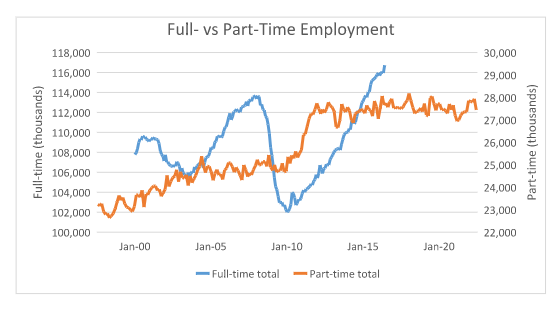The monthly jobs report produced by the Bureau of Labor Statistics (BLS) shows the number of new jobs created (or lost) in the economy. While the headline jobs numbers receive a lot of attention, less remarked upon is the division of these jobs into full-time or part-time work. For instance, in June 2016 the economy added 287,000 jobs. It turns out that all of this job growth was in full-time jobs. The economy added 787,000 full time jobs but lost 491,000 part-time jobs, resulting in net job creation of 287,000 (due to seasonal adjustment, data do not necessarily add to totals). However, this pattern was flipped the month before when the economy added only 11,000 jobs due to a combination of 128,000 lost full-time jobs and 139,000 new part-time jobs. The mix of full-time and part-time jobs likely has implications for the labor market, for people’s job prospects and wages. In general, part-time workers have much lower hourly wage rates and jobs with fewer fringe benefits. Before the recession, jobs growth was primarily due to an increase in full-time jobs. During the recession, this pattern reversed and the economy lost a significant number of full-time jobs and gained part-time jobs. Therefore, a full labor market recovery should be associated with a significant increase in full-time jobs. What has been the pattern since the recession?
The chart below uses data from the BLS to show the month-on-month increase in full-time and part-time work over a long window, January 2000-June 2016. This chart shows that during the recession, there was a significant jump in part-time work and a significant dip in full-time work. In fact, over the recession the share of part-time work in total employment increased from 18 percent to 21 percent, almost completely driven by the increase in involuntary part-time work. More recently, while levels of part-time work remain higher than before the recession, the recovery in full-time employment has contributed to a declining share of part-time workers in overall employment.
So what does this mean for the labor market? When it comes to full-time jobs, our economy has rebounded. In June 2016, we had 116.7 million full-time jobs as opposed to 109.6 million in June 2005. However, the number of part-time jobs has increased as well from 23 million to 27 million, with involuntary part-time workers increasing from 4.4 million to 5.8 million. These elevated levels of involuntary part-time workers are the reason why there is still considerable slack in the labor market, and why wage growth has not kept pace with the rise in full-time jobs. A recent study by the Federal Reserve Bank of San Francisco finds that, in recent years, about 80 percent of these part-time workers who have moved into full-time jobs have likely done so at below median wages, thus restraining median weekly earnings growth. Workers continuously employed in full-time jobs have received wage increases of 3.5 percent after inflation, while median wages for all workers have stagnated around 2 percent, unadjusted for inflation.
Going forward, we need to ensure that the economy is not only creating full-time jobs at a decent pace, but that the elevated levels of involuntary part-time work are reduced—not because people drop out of the labor force completely but because they transition to, and are able to remain in, high-wage full-time jobs.


